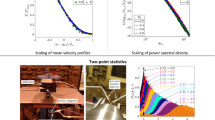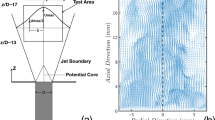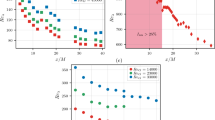Abstract
A family of autocorrelation functions and derivative statistics are measured by a rotating hot wire in a grid turbulence. The autocorrelation functions, at various probe radii and speeds, can be rescaled with the probe effective velocity suggesting that Taylor's hypothesis is satisfied. The effects of the random convecting speed and the temporal change which would violate the hypothesis are however effectively removed in computing the autocorrelation functions. For the derivative statistics, it is shown that the eulerian temporal derivative statistics can be determined from the time derivative statistics measured by the moving probe at two different speeds based on the principle of Galilean invariance. The Reynolds number dependence of the eulerian temporal derivative mean square values suggests that the main contribution comes from the nonlinear acceleration terms in the limit of high Reynolds number.
Similar content being viewed by others
References
Antonia, R.; Chambers, A. J.; Phan-Thien, N. 1980: Taylor's hypothesis and the probability density function of temporal velocity and temperature derivatives in a turbulent flow. J. Fluid Mech. 100, 193–208
Batchelor, G. K. 1951: Pressure fluctuations in isotropic turbulence. Proc. Cambridge Philos. Soc. 47, 359–374
Cantwell, B.; Coles, D. 1983: An experimental study of entrainment and transport in the turbulent near wake of a circular cylinder. J. Fluid Mech. 136, 321–374
Champagne, F. 1978: The fine-scale structure of a turbulent vector field. J. Fluid Mech. 86, 67–108
Chandrasekhar, S. 1955: A theory of turbulence. Proc. Roy. Soc. London Ser. A 229, 1–19
Coles, D.; Wadcock, A. 1979: Flying hot-wire study of flow past a NACA 4412 airfoil at maximum lift. AJAA J. 17, 321–329
Coles, D.; Cantwell, B.; Wadcock, A. 1978: The flying hot-wire and related instrumentation. NASA CR 3066
Comte-Bellot, G.; Corrsin, S. 1966: The use of a contraction to improve the isotropy of grid generated turbulence. J. Fluid Mech. 25, 657–682
Comte-Bellot, G.; Corrsin, S. 1971: Simple eulerian time correlation of full and narrow-band velocity signals in grid-generated ‘isotropic’ turbulence. J. Fluid Mech. 48, 273–337
Corsiglia, V. R.; Schwind, R. G.; Chigier, N. A. 1973: Rapid scanning, three-dimensional hot-wire anemometry surveys of windtip vortices. J. Aircr. 10, 752–757
Fisher, M. J.; Davies, P. O. A. L. 1964: Correlation measurements in a non-frozen pattern of turbulence. J. Fluid Mech. 18, 97–116
Freymuth, P. 1977: Frequency response and electronic testing for constant-temperature hot-wire anemometers. J. Phys. E. 10, 705–710
Gerich, R. 1975: A study of nonstationary relative velocity at the outlet of a Franics Turbine Impeler, using a rotating hot-film probe. Disa Info. 19, 19–25
Gorton, C. A.; Lakshminarayana, B. 1976: A method of measuring the three-dimensional mean flow and turbulence quantities inside a rotating turbo-machinery passage. J. Eng. Power 98, 137–146
Hekestad, G. 1965: A generalized Taylor hypothesis with application for high Reynolds number turbulent shear flows. J. Appl. Mech. 32, 735–739
Hah, C.; Lakshminarayana, B. 1978: Effect of rotation on a rotating hot-wire sensor. J. Phys. E. 11, 999–1001
Hinze, J. O. 1975: Turbulence, 2nd edn. New York: McGraw Hill
King, L. V. 1915: On the precision measurement of air velocity by means of the linear hot-wire anemometer. Philos. Mag. 29, 556–577
Lin, C. C. 1953: On Taylor's hypothesis and the acceleration terms in the Navier-Stokes equations. Q. Appl. Math. 10, 295–306
Lumley, J. L. 1965: Interpretation of time spectra measured in highintensity shear flows. Phy. Fluids 8, 1056–1062
Payne, F. R.; Lumley, J. L. 1966: One-dimensional spectra derived from an airborne hot-wire anemometer. Q. J. Roy. Met. Soc. 92, 397–401
Perry, A. E.; Watmuff, J. H. 1981: The phase-averaged large-scale structure in three-dimensional turbulent wakes. J. Fluid Mech. 103, 33–51
Perry, A. E.; Lim, T. T.; Chong, M. S. 1980: The instantaneous velocity fields of coherent structures in coflowing jets and wakes, J. Fluid Mech. 101, 243–256
Tennekes, H. 1975: Eulerian and lagragian time microscales in isotropic turbulence. J. Fluid Mech. 67, 561–567
Tennekes, H.; Lumley, J. L. 1972: A first course in turbulence, Cambridge, Massachusetts MIT Press
Walker, M.; Maxey, M. 1985: W whirling hot-wire anemometer with optical data transmission. J. Phys. E 18, 516–521
Weske, J. R. 1943: A hot-wire circuit with very small time lag. NACA TN 881
Wyngaard, J. C. 1968: Measurement of small-scale turbulence structure with hot-wires. J. Phys. E. 1, 1105–1108
Wyngaard, J. C.; Clifford, S. F. 1977: Taylor's hypothesis and high frequency turbulence spectra. J. Atmos. Sci. 34, 922–929
Wyngaard, J. C.; Tennekes, H. 1970: Measurement of the small-scale structure of turbulence at a moderate Reynolds number. Phys. Fluid 13, 1962–1969
Zaman, K. B. M. Q.; Hussain, A. K. M. F. 1981: Taylor's hypothesis and large-scale coherent structures. J. Fluid Mech. 112, 397–409
Author information
Authors and Affiliations
Rights and permissions
About this article
Cite this article
Sirivat, A. Measurement and interpretation of space-time correlation functions and derivative statistics from a rotating hot wire in a grid turbulence. Experiments in Fluids 7, 361–370 (1989). https://doi.org/10.1007/BF00193416
Received:
Issue Date:
DOI: https://doi.org/10.1007/BF00193416




